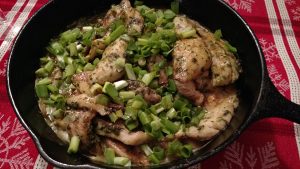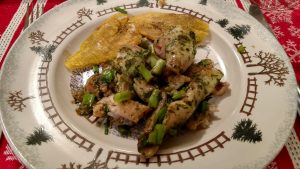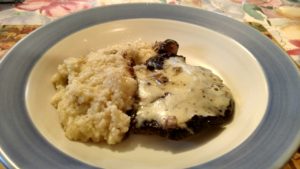CHULETAS DE CORNERO CON PAPAS (Broiled lamb Chops with Potatoes)
We Puerto Ricans love spicing up food. It’s in our nature. One of our favorite methods is dried spice rubs. This is a favorite with the old folks and the older generation. The beauty of these dishes was that you didn’t need fresh herbs. A lot of them were not available once a criollo family arrived on the mainland from the island during the great migration in the 1950s. Dried spice rubs became the norm. What’s singular about this method is that the longer the spice rub coating is left on the meat, the stronger the taste. It was also convenient. You coated the meat in the morning, went to work in a factory during the day, and when you got home, the meat was prepped for cooking.
This method of cooking has survived through the ages. Today I use the same spice rubs my parents used back in our apartment in Spanish Harlem. And one of our favorites was spicing up lamb chops. Then as now, it’s a great dish exploding with flavor. In this variation, I served the lamb chops with red potatoes. But you can use regular potatoes, if desired. In our household, we never stood on rigid formality.
Now, in this recipe, the game plan is thus: you rub the lamb chops with the spice rub, and then marinate them for the time desired. You grill the lamb chops while you boiled the potatoes to just tender. Remove the chops from the oven, replaced with seasoned potatoes and broiled them for a couple of minutes. Then serve both to the delight of family and friends.
CHULETAS DE CORNERA CON PAPAS
(Broiled lambs Chops with Potatoes)
Ingredients
8 lamb chops
2 teaspoons dried rosemary, crumbled
2 teaspoons garlic powder
1 teaspoon dried thyme
1 teaspoon dried oregano
1 teaspoon freshly ground black pepper
½ teaspoon salt
Pinch of cayenne pepper
3 tablespoons olive oil
Instructions
- Preheat broiler to high
- Wash lamb chops under cold running water and pat dry with paper towels.
- Combine rosemary, garlic powder, thyme, oregano, black pepper, salt and cayenne in a small bowl and mix well.
- Brush the lamb chops with the olive oil and rub the spice mixture into both sides of lamb. Let stand 1 hour at room temperature or, better yet, overnight in the refrigerator.
- Arrange chops on a shallow baking pan (I prefer cast-iron) and broil 5 minutes. Turn and cook until done (about another 5 minutes).
Yield: 4 servings
GRILLED POTATOES
2 pounds red potatoes, cut into chunks (do not peel)
2 tablespoons olive oil
Salt and ground black pepper to taste
- Wash the potatoes under running water. Place in a medium pot or pan, cover with water, bring to a boil, and cook until almost tender, about 10 minutes.
- Drain the potatoes, brush them with olive oil and season with salt and pepper.
- Place on a shallow baking pan and broil until tender, about 2-3 minutes, turning once or twice.


















